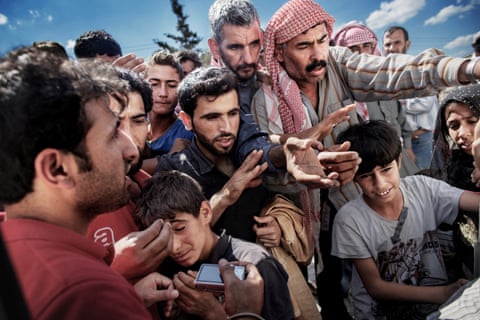Syrian refugees gather at a supply truck
Espen Rasmussen/VG/Panos
20 June I was in Akçakale on the Turkish side of the border with Syria (above) this summer, photographing migrants for the Norwegian newspaper VG. The border was closed and nothing much was going on, until a van stopped and volunteers inside started handing out things like soap and water. It was incredibly hot, 45C, and people were desperate. About 60 of them surrounded the van and somehow I managed to squeeze into the door to photograph them reaching out for these basic supplies. I was in front of everybody, so it seems like I’m the guy handing out the food.
It’s the light that makes this picture – the reason it almost looks like a studio shot is that the van was white, so it was reflecting the sunlight back on the people surrounding it. I had lots of comments when I posted the image on Facebook; some people didn’t think it was real.

Remains of Malaysian Airlines flight MH17
Dean Mouhtaropoulos/Getty Images
13 October As a sports photographer I don’t usually cover news. But I live near the airfield in the Netherlands where the Dutch Safety Board report into the downing of MH17 was being released, so I went along to cover it. This was the first time they described what the missile was (a Russian Buk), what the launch system was, and exactly what happened to the plane once it had been hit.
We went inside the plane. It had been recovered from Ukraine, and reconstructed like a jigsaw in a hangar. We walked through the skeleton of the fuselage, where a year ago there were families. That was the part that got to me the most. Everyone connects with being on a plane. That’s what makes this a strong image. It affected me quite badly. Being in the cockpit and seeing where the shrapnel had gone through the chairs, the description of how the plane broke up when the missile blew up. People who cover war and disasters learn how to detach themselves, otherwise you won’t survive. That’s why I could never be a war photographer – I can’t detach myself.
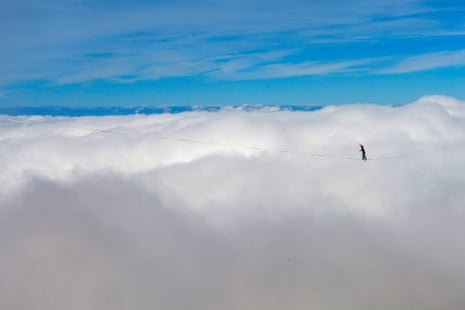
Highline walk
Jean-Christophe Bott/EPA
26 September The highline was strung between two sides of Moléson Peak, a mountain which curves round at the top like a circle in the Swiss Prealps. The peak is 2000m, just up above this huge area of sea fog, and sometimes the figure and the rope would disappear in the cloud. There were about 20 guys taking it in turns to walk the entire length of the highline without falling off, and they couldn’t do it. They kept falling. They were attached with a little rope, but I still had vertigo watching them.
For these guys, walking across the rope without falling is a personal and artistic achievement. The highlines are always getting longer and getting higher. Here you really get a sense of the difference between this giant area of fog, and the little guy. It’s about man fighting nature, fighting the elements, and fighting against fear.

Refugees rescued from the sea
Francesco Zizola/NOOR
23 August I was invited by Médecins Sans Frontières to document search and rescue in the Strait of Sicily. During the three weeks I was on board the ship, I witnessed the rescue of more than 3,000 migrants.
This image portrays a group of migrants, still wrapped in the shiny emergency blankets they used to keep warm during the two nights they spent on deck. After their long and troubled journey, this is the moment they catch sight of the land where they have long dreamed to arrive: Europe. The man in the forefront seems to know the land he is seeing may not be as welcoming as they all wish, and that he should not let his hopes run too wild.
On a crowded boat like this, the most critical aspect for a photographer is not what camera/lens combination to use, but how to be discreet and respectful. I hope that my images force people to put themselves in the shoes of those who risk everything to cross the Mediterranean and change the minds of those who don’t want to open the doors of their countries to them.
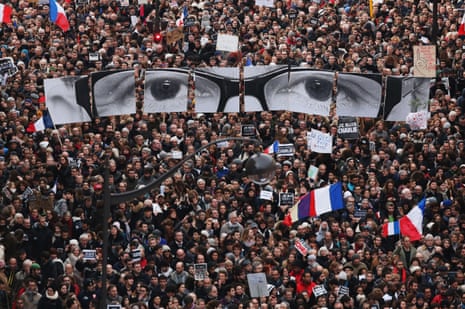
Charlie Hebdo unity march
Christopher Furlong/Getty Images
11 January The eyes were made by a French artist called JR and all credit goes to him, because he made this picture, not me. They are the eyes of Stéphane Charbonnier who was the editor of Charlie Hebdo. We knew there was going to be a massive unity march and the best way to show the maximum number of people was from up high. It was quite difficult to find that spot, because all the residents around the Place de la République had been told by the police not to allow any strangers on their roofs or balconies for security reasons. In the end a colleague and I managed to book a room in a hotel where I shot this.
The image shows the very beginning of the march, where it started on Rue Voltaire. I captured the eyes in the top of the frame – a classic rule of thirds composition. It was amazing and incredibly humbling to see so many people united together with one voice. I felt privileged to be able to take this photograph.

‘Blood moon’ eclipse
Phil Walter/Getty Images
4 April I heard that the lunar eclipse “blood moon” was going to take place, but it was so late at night that it wasn’t a big spectator event in New Zealand. It had been cloudy most of the day and I wasn’t sure if we were going to see the eclipse or not, but we were lucky and it cleared up.
I shot the eclipse from my front porch using a 600mm lens on a tripod, and took maybe 50 or 60 pictures. I really wanted to place the moon next to something land-based, like a building or a church steeple, but it wasn’t a low moon sitting on the horizon. In fact it was quite hard to focus, because the camera was at an acute angle – pointing straight up into the sky – which is difficult when you’re using such a big lens. I didn’t edit this image at all, but you can alter the white-balance settings in the camera, which gave it a warmer, more saturated feel. But even with the naked eye you could see the reddish tinge.
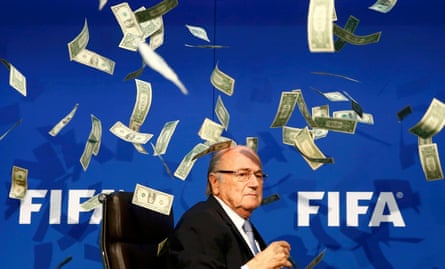
A shower of banknotes for Sepp Blatter
Arnd Wiegmann/Reuters
20 July We were gathered for the news conference after the Fifa executive committee meeting in Zurich. Suddenly this guy wearing a suit stood up at the front and went towards Blatter. We found out later he was the British comedian Simon Brodkin. He had two packets of dollar notes. Blatter was surprised and started saying, “Where’s my security?” When the guards arrived Brodkin turned towards Blatter and threw the bank notes in the air. I had been using a zoom lens, but I quickly changed it for a wide angle lens. The entire situation was a bit less than 20 seconds and I shot 80 frames as the notes fell slowly and perfectly around Blatter.
I love this picture because it is not the Sepp Blatter we know. He looks helpless, and his eyes look a little sad.
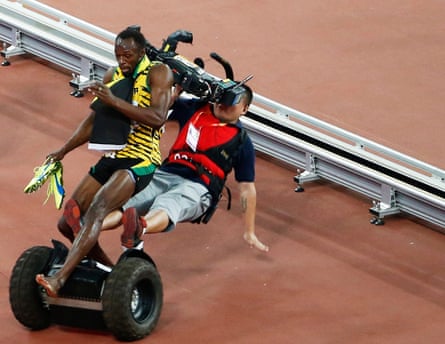
Usain Bolt is felled by a Segway cameraman
Rolex dela Pena/EPA
27 August Usain Bolt had just won the 200m at the Beijing World Championships. He started doing his victory lap, and I decided to follow him with my camera, just to see if anything else happened. Camera operators on Segways were a new thing – very unusual. One camera guy was following Bolt, when all of a sudden he hit him from behind. I clicked my camera at that moment – it was accidental. My first thought was: I hope Bolt’s all right. It was a scary moment. But Bolt got up and seemed to be OK.
One photographer said to me: “You’re proof that it pays to wait”. The victory walk is just an ordinary moment. But I wanted to capture something different, and I guess I got it.

Chile’s Calbuco volcano erupts
Alex Vidal Brecas/EPA
22 April When the Calbuco volcano started erupting, I was getting ready to celebrate my birthday. We were about 30km from Puerto Montt, the city closest to the volcano. I got a call from a news agency asking me to get an image of the volcano that also encapsulated the real threat to the population. It was the first time the Calbuco had erupted in 43 years. At first no one noticed, but soon people were freaking out, as it’s impossible to predict how dangerous a volcano will be.
The opportunity for the photo came at dusk, 45 minutes after the eruption. I took others, but they don’t have the same colour scheme. I didn’t have my usual equipment with me – just a small compact camera.
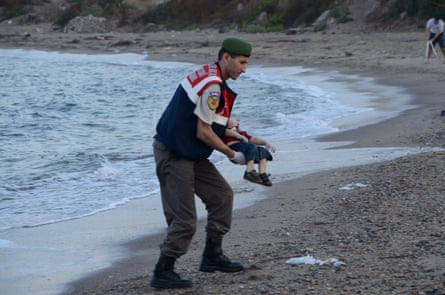
The body of Alan Kurdi
Nilufer Demir/DHA
2 September Speaking to Turkey’s Dogan News Agency (DHA), Demir said: “At that moment, when I saw the three-year-old Alan Kurdi, I was petrified. The only thing I could do was to make his outcry heard. At that moment, I believed I would be able to achieve this by clicking the shutter of my camera, and I took his picture.
“We were covering the illegal transition of migrants to the Greek island of Kos from Bodrum’s coast. Suddenly we noticed the lifeless bodies. We recognised they belonged to toddlers. We were shocked, we felt sorrow for them. I have photographed and witnessed many migrant incidents since 2003 in this region – their deaths, their drama. I hope from today, this will change.”
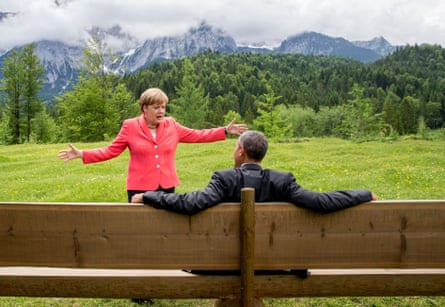
Merkel and Obama’s private moment
Michael Kappeler/EPA
8 June We had just done a big picture with all the heads of state on that bench which is in front of Schloss Elmau [the G7 summit venue]. I spotted Obama sitting alone and I thought: that’s a nice picture. I tried to take it, but there were lots of security guards. Merkel arrived and suddenly I found my chance. The moment Merkel opened her arms was less than a second. There was no one directing the shot. It was an accident. The picture was used on front pages all over the world.

A man climbs the security fence in Calais
Mustafa Yalcin/Anadolu/Getty Images
3 August This area, Coquelles, is about 3km from the Jungle refugee camp where most of the migrants live. They travel to the fence at night hoping to evade the police. I was following a group when suddenly they started running. There were about 20 of them. They got to the other side, but the police arrived and captured them. The migrants know they might die trying to get to England, but it is their last hope.
Technically, I like the picture – it was dark, but there is lots of light. But it’s not a joyous photo. If you hear the stories of the migrants, you can’t feel good.
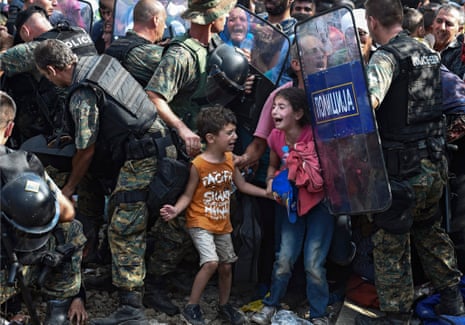
Macedonian border police clash with refugees
Georgi Licovski/EPA
21 August That was a terrible day. I’ll never forget it because it was the day I saw my colleagues cry. Migrants were coming from Greece trying to get to Europe, but the Macedonian border was closed. The police were sent an order not to let anyone pass. The migrants put the women and children at the front, then the men started to push from behind. Then the hell started. The crying women and children tried to pass through the cordon. You can see the horrified faces of the children. They were crying out, “Where is my brother? Where is my sister? Where is my mum?”
Our position meant we could shoot from a few metres away, but we couldn’t help the children. Some Macedonian officials weren’t happy with my picture. But the police were not being brutal, they were trying to help the children, to make space. This has become one of my most published pictures. Many newspapers published it. I’d prefer they publish my sports photography. I don’t like to take a picture of crying children. Afterwards, you can’t sleep. I don’t know about the morality of our pictures in that moment. For the first time in my life I have doubts.
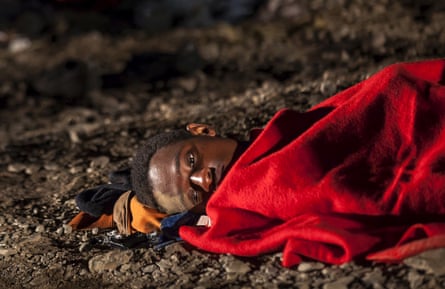
African refugee rests after arriving in Gran Canaria
Borja Suarez/Reuters
2 September When pateras (refugee boats) arrive at Gran Canaria, they usually don’t make it to the beach – there are surveillance systems that intercept them miles away.This time they reached land, and it all happened very quickly – I got a call from the Red Cross, grabbed my equipment and got there before the emergency services. There were people scattered over the beach with wet clothes, resting or lying down, and it was dark. There was one baby.
I often wonder what would make someone risk their life on a crammed dinghy – and you realise it when you look them in the eyes. That look of fear, sadness, pain, anger, helplessness – it’s telling you his entire story.
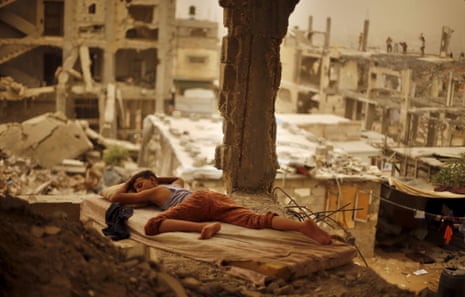
Palestinian boy asleep in a sandstorm
Suhaib Salem/Reuters
8 September A huge sandstorm swept through Gaza. You could smell it, feel it. It turned everything yellow. You couldn’t see cars or people in the street. It lasted for five hours. I was thinking about the people who lost their houses in the 50 day war in 2014. I went to the Shejaiya neighbourhood, less than a 1km away from the Israeli border in the east of Gaza, which was almost completely destroyed by Israeli shelling: it was shelled in 2000, in 2008, 2012 and 2014. The people are used to it now. I ask them, “Aren’t you scared to build your house here?” They say: “I know my house is going to be destroyed, but what can I do?”
Most people in the neighbourhood have left, but the men of this family still live in the lower floor of the house. I found this boy sleeping. I thought: he’s in another world, completely asleep. The picture shows how difficult life is for these people. No one can imagine a boy could sleep in a place like this. But it’s normal for the children now. They were born like this, and they continue their life like this. There is no other option.
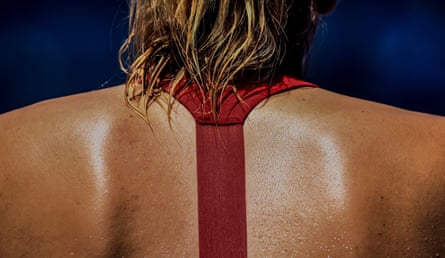
Maria Sharapova at the Australian Open
Filip Singer/EPA
21 January I had to wait for this shot for three days. It was 45C. When the players sat down, they were immediately covered up with umbrellas to shade them from the sun. Maria Sharapova is a great subject to photograph. She always has her long hair flying around, she’s animated, she wears interesting dresses. There are only a few players who everyone wants to photograph – players like Sharapova, Williams and Djokovic. Someone like Federer isn’t interesting, he’s too calm.
I liked this dress because you can see how strong she is. I didn’t want to take just another tennis action shot. So I waited to get a clear shot of her back at the moment she sat on the bench, before she was covered with the umbrella. I had literally one second. I knew it wasn’t a news picture, so I didn’t file it straight from my camera. I edited it after the game, cropped it, so I could tell the story I wanted to. The shot shows Sharapova’s power. You can see her big muscles, how much she is sweating. I wanted to show how hard this sport is and how hard the players have to work.

Aerial view of explosion in Tianjin
Chen Jie/The Beijing News/Reuters
19 August A warehouse, where large amounts of toxic chemicals were stored, exploded on 12 August, killing 165 people and injuring more than 100 others. I had been to the blast area, but there was a large amount of toxic smog, and I couldn’t reach the central area. So I selected a tall building about 1,000 meters away and climbed to the top. The image was taken by a drone at a height of 300m.
I was shocked, really. From the air, it was more impressive that high buildings, congested containers and numerous vehicles were just like toys which could be easy to be damaged. I have photographed natural disasters like the Wenchuan earthquake in 2008, and the Great East Japan earthquake in 2011, which created considerable devastation. But this was the first man-induced accident, and it generated even more powerful feelings. The picture has been published on The Beijing News – most of the comments were “shocking”, “horrifying”, “it’s no better than a battlefield
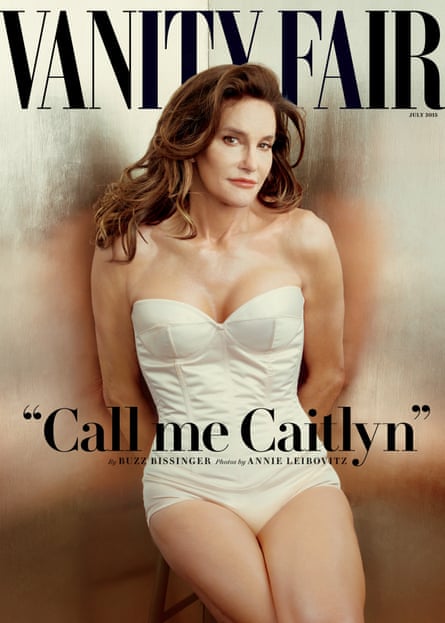
Caitlyn Jenner’s Vanity Fair cover
Annie Leibovitz/PA
1 June Speaking to Vanity Fair editor Graydon Carter, Leibovitz said: “We basically did it all in [Jenner’s] house. The idea was that we would try on all the clothes and go through it – it really was a two-day session of emergence. She really did emerge.
“That was one idea with the corset. I originally wanted to be more conservative with her and was looking at photographs of Katharine Hepburn. I realised that whatever look she had was going to be an acquired look. This was an acquired idea of ‘What is a woman?’ What should a woman look like? How does a woman dress up? Who is Caitlyn? I think our whole team really wanted it to be successful for her, and we wanted to take her over the hill. Now I think she has a long road still to go but I think what she’s done so far is pretty amazing.”

Model ‘wears’ a model
Francois G Durand/WireImage
1 October My first impression when I saw the models was that they were carrying a fake model. I couldn’t imagine that a women was wearing another woman, but as they came closer we could see they they were carrying something heavy, that it was not easy and that it was a real person. The woman being carried upside down was completely red, it looked really funny; all the photographers were laughing.
For me, this image is interesting because we’re not looking at the fashion. It’s something different. I was waiting for something exceptional and when I saw the models arriving together, I knew that would be huge. Usually I find fashion shows boring, but this was not just about the clothing.

A victim lies dead outside the Bataclan theatre in Paris
Jerome Delay/AP
13 November Usually Paris at midnight on Friday is very festive, noisy, there’s a lot of people on the street. That night, I sensed an eerie quietness. There was barely any traffic. As I approached the 18th arrondisement, there were more and more police, firefighters, first responders, even the army. Triage centres were set up in restaurants across from the Bataclan. It was very hard to get through – the last thing I wanted was to get in the way of these people doing their jobs, but I had to do my job and find out what was happening. I spotted this one body lying on the pavement, and I just snapped three frames – bam, bam, bam – without thinking much.
I was absolutely stunned by the response. People saw things that I didn’t see. There are the posts, which look almost like people at a funeral. The dead leaves surrounding the body. I’ve photographed dead people my entire professional life. I don’t know who this person is, and maybe in this case it’s better that way. The picture represents all the victims.

Flowers and candles at Le Carillon, Paris
Loic Venance/AFP/Getty Images
15 November I took this on the Sunday after the attacks. The sun had just set, there were a lot of people paying their respects and it was very crowded, but everyone was silent. One woman had brought a radio and it was playing a song by Jacques Brel, If You Only Have Love. A little girl came up to light the candles. It was a very emotional moment. The building was covered in bullet holes – in the walls, on the windows, through the awning. I know Le Carillon well. I’ve lived close by for almost 12 years, and I’ve eaten there and at Le Petit Cambodge nearby. It’s my neighbourhood.
I felt this scene was very symbolic. It’s broken, it’s horrible, but it’s also beautiful. It has that duality. The restaurant reopened recently. Of course I will go back. Just yesterday I was drinking beers on the terrace very close by with friends. I’m not particularly afraid. The first time I go back to Le Carillon it will be a bit emotional because of the memory. But I’m not afraid.
